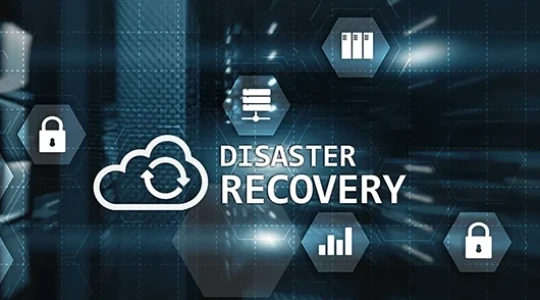Cloud infrastructure is one of the main demands of the modern market, as it contributes to increasingly profitable and flexible operations. However, as this technology expands and gains followers across a wide range of industries, the security of virtual environments becomes more complex.
In practice, the growing adoption of cloud solutions also opens the door to increased network vulnerabilities and raises growing concerns among businesses about this issue. According to Cybersecurity Ventures, for example, global costs to combat cybercrime are expected to reach $10.5 trillion annually by the end of 2025.
The need to protect sensitive data, ensure compliance with legal regulations, and strengthen brand values such as transparency and compliance are some of the key factors behind these significant figures.
That’s why it’s both important and necessary for modern companies to develop corporate strategies focused on implementing cloud infrastructure security solutions that can overcome common challenges without compromising business performance.
Not sure how to get started? This article will help you.
What are the challenges of cloud security?
Before outlining any strategy for incident response or prevention of extreme events associated either with cybercrimes and system failures or with weather conditions or human errors, it is necessary to understand the risks of a cloud infrastructure.
To make it easier to visualize these challenges in the corporate environment, we can didactically divide them into two major groups: internal risks and external risks. See below:
Main Internal Cloud Security Risks
Lack of infrastructure knowledge and resulting human errors
Although it is an area often overlooked by companies, training the team can mitigate a large part of the security risks in a cloud environment.
When a team does not understand the resources made available by the cloud and that they use in their daily work and functions, or does not even master the best practices of virtual navigation, security gaps arise that can and will be exploited by malicious agents.
For example, improper permission settings, negligence in security updates, and classic phishing can compromise an organization’s critical data, putting its entire operation on alert.
Basic changes in routine and work planning can reverse this situation by structuring a schedule of regular training and the development of a strong cybersecurity culture that is widespread among employees.
Configuration vulnerabilities
Cloud configuration inconsistencies are channels frequently exploited by cybercriminals.
Weak passwords, unencrypted systems, or unnecessary open ports in the network are a direct invitation to attacks and to the compromise of cloud infrastructure security.
To mitigate this scenario, which is currently one of the main causes of cloud breaches, it is essential to adopt strict processes and conduct regular audits to identify and fix issues before they become a threat.
Lack of continuous cloud monitoring
In the same sense as the previously mentioned risk, the lack of cloud monitoring results in the failure to identify suspicious activities.
When this happens and there is no quick response to harmful events, such as unauthorized access or unexpected data alteration and corruption, the damage is enormous.
This is because in the business world, where every second "offline" represents loss of business and opportunities, not having a well-defined strategy for incident response and identification can be fatal.
A poorly strategic Identity and Access Management
A champion of negative impacts on business, poor identity and access management is closely linked to the absence of clear security policies, monitoring, and cloud updates.
The use of shared accounts or global permissions for all users significantly increases the chances of unauthorized access.
For this reason, solutions such as multi-factor authentication (MFA) and the principle of least privilege are best practices that help mitigate this risk.
Non-compliance with data regulations
Finally, one of the cloud security risks that should be prioritized for correction is companies' non-compliance with data regulation provisions.
Currently, a few years after the implementation of the most relevant regulatory standards around the world, sectors have strict compliance requirements, such as those imposed by the GDPR (General Data Protection Regulation) in the European Union and the LGPD (General Data Protection Law) in Brazil.
When actions that ensure data protection, as promoted by these regulations, are absent, there is the potential for fines, lawsuits, and the consequent loss of customer trust.
Seeking cloud solutions that already offer compliance is an excellent way to overcome this issue.
For example, tools like Oracle Data Safe and Microsoft Compliance Manager help companies audit and monitor compliance with regulations such as LGPD, GDPR, and HIPAA, ensuring that data is always protected and in compliance.
While Oracle Data Safe enables organizations to understand data sensitivity, assess data risks, mask sensitive data, implement and monitor security controls, assess user security, and monitor user activity, Microsoft Purview Compliance Manager automates the compliance management of the entire multicloud environment.
In the latter, processes include data protection risk inventory through to the management of the complexities of implementing controls, for constant updates on regulations and certifications, and reporting to auditors.
Lack of visibility and technical capacity to manage multicloud environments
In multicloud environments, security can be a challenge due to the lack of unified visibility and also the absence of technical capacity from teams in managing them.
Each cloud provider has its own security tools and protocols, which can make it difficult to identify and respond to threats in a centralized manner.
Without efficient monitoring, companies risk suffering from incorrect configurations, unauthorized access, and undetected vulnerabilities.
To mitigate these risks, solutions like Oracle Cloud Infrastructure Security and Microsoft Azure Arc allow for managing and protecting resources distributed across different clouds from a single control panel.
These tools offer security policy automation, real-time threat detection, and continuous compliance, ensuring greater protection and governance over the company's digital assets.
Main external cloud security risks
Cyber threats and cybercrimes
The increase in cloud usage also attracts more targeted attacks. Ransomware, for example, can encrypt a company’s data, demanding million-dollar ransoms.
Other attacks, such as phishing, exploit human vulnerabilities to access critical systems, putting both confidential information and the organization's operations at risk.
Additionally, with the advancement of Artificial Intelligence (AI) and the sophistication in cybercrime programming, it is becoming increasingly challenging to identify and combat these threats. Techniques such as deepfake for financial frauds and malicious bots are among the new threats that require extra attention.
For this reason, cybersecurity focused on risk mitigation strategies and incident response is a priority for companies across all sectors.
In this regard, trusted cloud service providers, combined with advanced protection solutions like AI-based detection and next-gen firewalls, can help reduce the attack surface and protect operations more effectively.
Weather conditions
Although cloud infrastructures are designed to be robust, they are not immune to natural disasters. Data centers, which are the physical foundation of cloud storage, can be affected by extreme weather conditions such as hurricanes, floods, earthquakes, or wildfires.
These events can cause direct damage to equipment, such as servers and cooling systems, or lead to power outages and network connection disruptions that keep services running.
For example, if a data center located in a flood-prone area is hit, critical systems may be shut down as a safety measure, or even suffer irreparable damage, resulting in the temporary or permanent unavailability of stored data.
To mitigate these risks, leading market providers like Oracle adopt strategies such as geographical redundancy, where data is replicated and stored across multiple geographical regions.
Thus, if one data center is compromised, another can take over its functions, ensuring service continuity and minimizing impacts for users.
Monolithic vulnerabilities
Pointed out as one of the main cloud security risks for 2025, the dependence on the same technological supply chains can create significant vulnerabilities where a single compromised entity affects the others, causing widespread disruption.
In an article for Forbes, cybersecurity expert Nimrod Kozlovski, founder and CEO of Cytactic, stated: "Organizations need to prepare not only for internal incidents but also for vulnerabilities in their supply chains."
- Change Healthcare – the cyberattack on the group led to the exposure of personal and health data of over 100 million individuals.
- CrowdTrike – a faulty update of software used in Microsoft Windows systems affected around 8.5 million computers globally.
Solutions to tackle these challenges and enhance Cloud Infrastructure Security
Now that you are familiar with the main risks associated with cloud infrastructure security, it's time to think about solutions!
Ensuring security in the cloud environment is an ongoing process that requires a combination of best practices, advanced technologies, and constant monitoring. Below, we present a table with practical solutions and tools that help mitigate the risks discussed earlier.
| Challenge | Solutions/Best Practices | Tools |
| Lack of infrastructure knowledge and human errors |
Regular training for the team and development of a cybersecurity culture.
|
- |
| Configuration vulnerabilities | Regular audits and strict configuration processes | Oracle Cloud Guard |
| Lack of continuous cloud monitoring |
Real-time monitoring and automatic alerts for suspicious activities |
Oracle Cloud Observability and Management Platform |
| Poor identity and access management | Implementation of multi-factor authentication (MFA) and use of the principle of least privilege | Okta Identity Cloud |
| Non-compliance with data regulations | Compliance tools and audits to ensure compliance | Oracle Data Safe |
| Cyber threats and cybercrimes | Advanced firewalls, AI-based detection, and regular security updates | Oracle Cloud Infrastructure Web Application Firewall (OCI WAF) |
| Weather conditions | Geographical redundancy and data centers in multiple regions | Oracle Autonomous Data Warehouse with redundancy |
| Monolithic vulnerabilities | Supply chain segmentation, diversification of technology providers | Oracle Maximum Availability Architecture |
In addition to these, other tools can be very interesting to tackle challenges and optimize cloud security. They are:
- Oracle Identity and Access Management (IAM) - implementation options to protect workloads both on-premises and in the cloud, with flexible and scalable protection.
- Oracle Cloud Infrastructure (OCI) - the only cloud that offers complete cloud services worldwide, between clouds or in your data center.
- Oracle Security Zones - enforces a security posture on OCI cloud compartments and prevents actions that may weaken a customer's security posture. It is a cloud security posture management for Oracle Cloud Infrastructure.
- Microsoft Defender for Cloud - a CNAPP (Cloud Native Application Protection Platform) that brings together a set of security practices and measures aimed at protecting cloud applications from cyber threats and vulnerabilities, ensuring a safer and more resilient environment.
- Azure Security Center - a security management tool that allows you to gain insights into your security state in hybrid cloud workloads, reduce exposure to attacks, and respond quickly to detected threats.
- Azure Sentinel (SIEM) - a cloud-native security event and information management platform that uses integrated artificial intelligence to quickly process and analyze large volumes of data within a company, facilitating threat detection and response.
- Azure Active Directory (AD) - enables the management and protection of user identities and access in multi-cloud and hybrid environments.
How does Prime DB help your business implement these best practices?
In addition to offering technology, Prime DB is committed to delivering peace of mind to its clients, allowing businesses to focus on what really matters: operational scalability.
As an Oracle partner, one of the global leaders in database and cloud infrastructure solutions, Prime DB combines the expertise of an industry giant with a personalized approach tailored to your business model.
Through Prime DB solutions, you have access to various benefits, such as:
- Robust and scalable infrastructure.
- Advanced security technologies.
- Guaranteed compliance.
- Specialized technical support.
In practice, Prime DB also ensures the security of your organization's data so that you can secure business growth.


